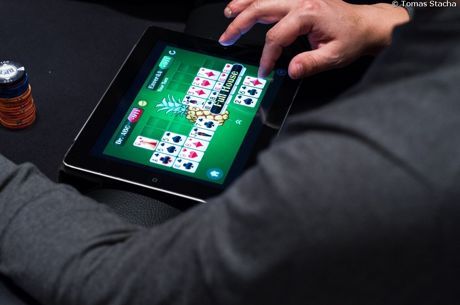Bankroll Builders, Vol. 12: Double or Nothing SNGs, Part 2

In our last edition of Bankroll Builders we introduced you to the Double-or-Nothing sit-n-go, a single table tournament where the top five finishers earn double their buy-in while the rest of the field leaves with nothing. Proper DON strategy is quite different from what you may be used to (and the bubble can be excruciating), but don��t worry. We��ve got you covered.
Before you register
Identify the regulars. Before buying in, look through the games open for registration at the limit you��ll be playing. Chances are you will see many of the same players registered across several SNGs. These are the multi-tabling regulars. Take note of their screen names and buy in to the games with the fewest regulars already registered. Your profit will primarily come from the non-regs who do not understand the strategic quirks of DONs.
Understand your equity. At the beginning of a DON, your 1,500 chips are worth the same amount as your buy-in. If you��re in a $10 tournament, your chips are worth $10. But let��s say you double up early and increase your stack to 3,000. Your chips are now worth $15.55. Although your stack may be twice its starting size, your equity has only increased by a bit more than 50 percent. A bit of simple arithmetic will tell you that risking your entire stack that early will only be profitable if you win that all-in about two-thirds of the time. (10/15.55=64.3%). But what about the other $4.45? That equity is divided among the other eight players. The more people who bust out, the more value your opponents�� chip stacks gain.
Early-stage play (10/20 through 25/50 blinds)
Fold, fold, fold. Forget playing ��tight.�� In the first few levels of a DON, it��s time to seriously nit it up. From early and middle position, open-raise with only the most premium of premium hands �� pairs above sevens, and ace-king. Consider ace-queen suited as the bottom of your range. If the action is folded to you in late position, you can widen that range a bit based on the players still to act behind you. If a couple of tight regulars are sitting in the blinds, it��s OK to open wider on the button, but be prepared to let it go if you encounter any resistance. Concentrate on preserving your stack rather than attempting to chip up early.
Middle-stage play (25/50 through 75/150 blinds)
At the 25/50 level, the antes kick in. You know what that means �� time to start stealing. It��s essential when it comes to preserving your stack. By this time, you should have an idea of who the active players are at your table and who is playing only strong starting hands. Target the tight players when stealing, but be extremely mindful of stack sizes. Avoid the larger stacks that could bust you, and the short stacks, who will be willing to go all-in with a less-than-optimal hand.
Also avoid flat-calling raises at this stage of the game. If you��re facing a raise, either reraise or fold. Simply calling represents too large a percentage of your stack at this point. If your opponent has shown willingness to fold to a shove, put pressure on him. However, if you��re facing a looser player who is more likely to call, wait for another hand.
Bubble play (100/200 blinds and beyond)
With six players remaining, and the blinds this high, there are only two options �� shoving or folding. If you have a large stack at this point, congratulations, you��re in great shape and can probably fold your way to the money. If you��re a small to average stack, pick good spots to move all-in and pick up the blinds, which will represent a significant gain at this stage. A good spot to shove is against thinking players and regulars who will fold a large percentage of the time. Don��t try anything fancy, like limping in with aces or kings to induce a shove. Shove instead and hope for a call.
Moving all-in to steal is one thing. Calling an all-in is something else altogether, and is not advisable in this stage of play unless you (a) are one of the big stacks and a very short stack has moved in, or (b) have aces. Even if you do have aces in that situation, you may want to fold them anyway. If you��re a big stack, it��s not your responsibility to knock out the short stacks. Focus on maintaining your own stack and let them cannibalize themselves.
Think you'd crush the double or nothing SNGs? Open an account on PokerStars and give 'em a whirl.








